Salvador Dalí (1904 – 1989) was a Spanish artist who is most famous for his works in Surrealism, an influential 20th century movement, primarily in art and literature. Surrealist artists rejected the rational in art; and instead aimed to channel the unconscious to unlock the power of imagination. Dali used extensive symbolism in his work. Recurring images in his paintings include elephants with brittle legs which evoke weightlessness; ants, thought to be his symbol for decay and death; and melting watches, perhaps symbolic of non-linear human perception of time. Dali’s contributions to Surrealism include the paranoiac-critical method. Though he was expelled from the movement due to clashes with its members, Dali became the most influential Surrealist artist; and perhaps the most renowned twentieth century painter after Pablo Picasso. Here are the 10 most famous paintings of Salvador Dali.
#10 The Burning Giraffe
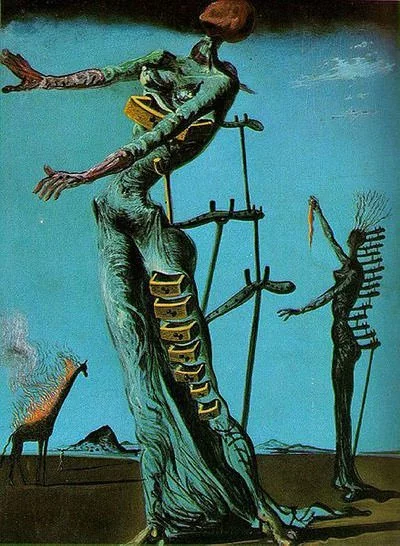
| Spanish Title: | Jirafa en llamas |
| Location: | Kunstmuseum Basel, Switzerland |
| Year: | 1937 |
The Burning Giraffe is seen as an expression of the personal struggle of Salvador Dali with the civil war going on in his home country. The painting depicts two feminine figures with undefined phallic shapes protruding from their backs. The hands, forearms and face of the nearest figure are stripped down to the muscular tissue beneath the skin. Prominently, there are opened drawers protruding from the left leg and chest of the figurine. Salvador Dali was a great admirer of famous neurologist Sigmund Freud and several paintings of Dali were influenced by Freudian theories. These open drawers can be traced to Freud’s psychoanalytical method and refer to the inner, subconscious within man. The burning giraffe image in the background was described by Dali as, “the masculine cosmic apocalyptic monster.” He believed it to be a premonition of war.
#9 Tuna Fishing (Homage to Meissonier)
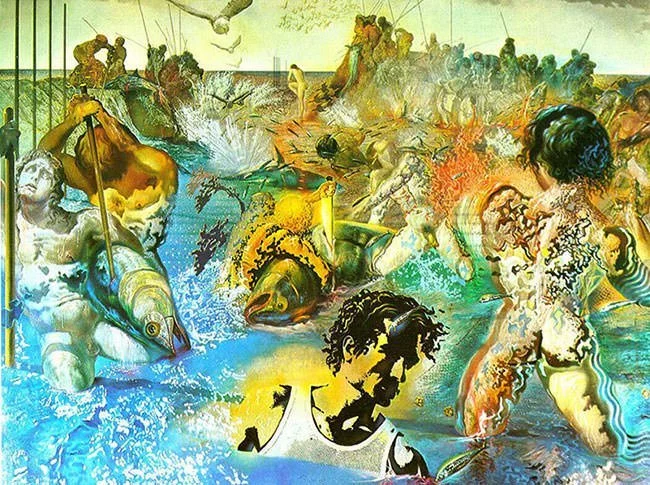
| Spanish Title: | La Pesca del Atún |
| Location: | Foundation Paul Ricard, Ile de Bandol, France |
| Year: | 1967 |
This painting was created by Salvador Dali at the end of his illustrious career and is considered to be his last great masterpiece. He spent two summers to create the artwork in which, apart from surrealism, he has used styles such as Action painting, Pop Art, Pointillism, geometrical abstraction and psychedelic art. Including images from ancient Greek sculpture to modern cinema, Tuna Fishing depicts violent struggle between men and large fishes as a personification of the limited universe. The painting is dedicated to Jean Louis Ernest Meissonier, a 19th century French painter known for his depictions of battle scenes. Dali considered Tuna Fishing to be his most ambitious work and it is considered by his fans a testament to the mastery he had acquired in his profession during his career.
#8 Dream Caused by the Flight of a Bee
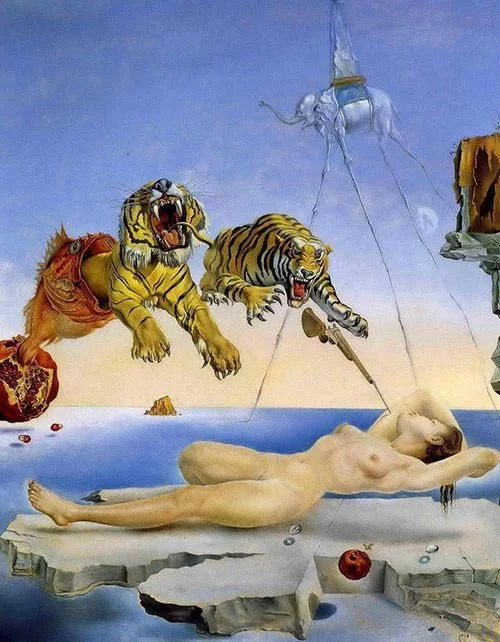
| Spanish Title: | Sueño Causado por el Vuelo de una Abeja |
| Full Title: | Dream Caused by the Flight of a Bee Around a Pomegranate a Second Before Awakening |
| Location: | Thyssen-Bornemisza Museum, Madrid, Spain |
| Year: | 1944 |
Salvador Dali said that this painting was intended “to express for the first time in images Freud’s discovery of the typical dream with a lengthy narrative, the consequence of the instantaneousness of a chance event which causes the sleeper to wake up.” It shows the sleeping figure of the artist’s wife Gala Dali floating above a rock. Beside her naked body, two drops of water, a pomegranate and a bee are also airborne. Gala’s dream is prompted by the buzzing of the bee and is portrayed in the upper half of the canvas. In a succession of images, a pomegranate bursts open to release a giant red fish from whose mouth two ferocious tigers emerge together with a bayonet which will soon wake Gala from her restful sleep. The elephant, later a recurring image in Dali’s works, is a distorted version of Elephant and Obelisk, a sculpture by famous Italian artist Gian Lorenzo Bernini.
#7 Galatea of the Spheres
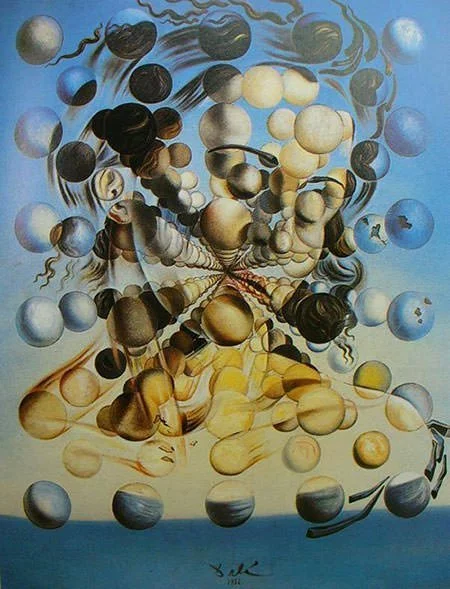
| Spanish Title: | Galatea de las esferas |
| Location: | Dalí Theatre-Museum, Figueres, Catalonia, Spain |
| Year: | 1952 |
After the atomic bombings of Hiroshima and Nagasaki, Salvador Dali became captivated with nuclear physics and the theories of disintegration of the atom. It was also a time when he had renewed interest in Catholicism. The led to his Nuclear Mysticism period, in which his works often used ideas from modern science as means of rationalizing the Christian religion. Realizing that matter was made up of atoms, Dali made his works appear to disintegrate into multiple atoms. This painting is a portrait of Gala Dali, his wife and muse. Her face is composed of densely populated spheres, representing atomic particles, which give a marvelous three dimensional effect to the canvas. Galatea in the title refers to a sea-nymph in Classical Mythology named Galatea, who was renowned for her virtue. Galatea of the Spheres is one of the most renowned paintings from Dali’s Nuclear Mysticism period.
#6 Metamorphosis of Narcissus
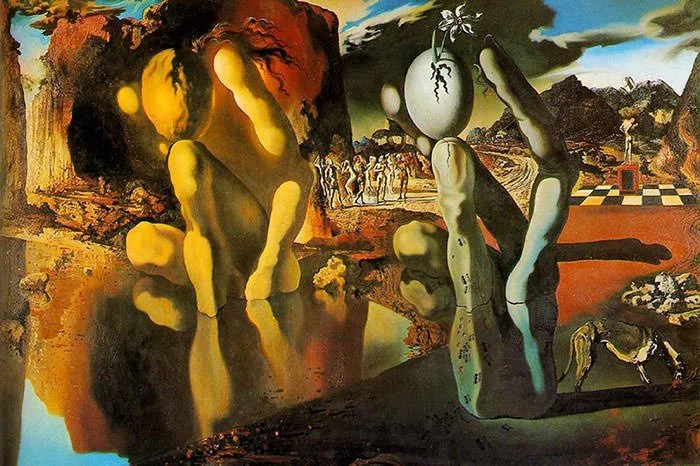
| Spanish Title: | La metamorfosis de Narciso |
| Location: | Tate Modern, London, U.K. |
| Year: | 1937 |
The paranoiac-critical method is a technique in Surrealism which was developed by Salvador Dali in the early 1930s. It is used by the artist to tap into his subconscious through systematic irrational thought and a self-induced paranoid state. Considered one of the main achievements of surrealism, Dali used it in several of his paintings, especially those involving optical illusions and other multiple images. According to Greek mythology, Narcissus, who was renowned for his beauty, fell in love with his own reflection in water. Dali’s interpretation of the Greek myth, this painting shows Narcissus sitting in a pool, gazing down. Metamorphosis of Narcissus was created by Dali during his paranoiac-critical period and is among his most renowned works using the technique.
#5 Christ of Saint John of the Cross
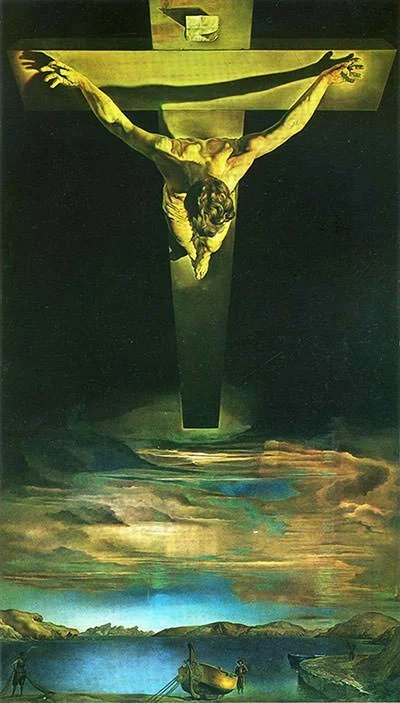
| Spanish Title: | Cristo de San Juan de la Cruz |
| Location: | Kelvingrove Art Gallery and Museum, Glasgow, Scotland |
| Year: | 1951 |
This painting is known as Christ of Saint John of the Cross because its design is based on a drawing by the 16th-century Spanish friar John of the Cross. The composition consists of a triangle, which is formed by the arms of Christ and the horizontal of the cross; and a circle, which is formed by the head of Christ. The triangle might be seen as a reference to the Holy Trinity while the circle may represent unity, that is all things exist in the three. Although the painting is a representation of crucifixion, it is devoid of nails and blood. According to Dali, the inspiration of the painting came to him through a cosmic dream, in which he was convinced that depiction of nails and blood would mar his portrayal of Christ. Christ of Saint John of the Cross was voted Scotland’s favorite painting in a 2006 poll and it is considered by many to be the greatest religious painting of the twentieth century.
#4 The Great Masturbator
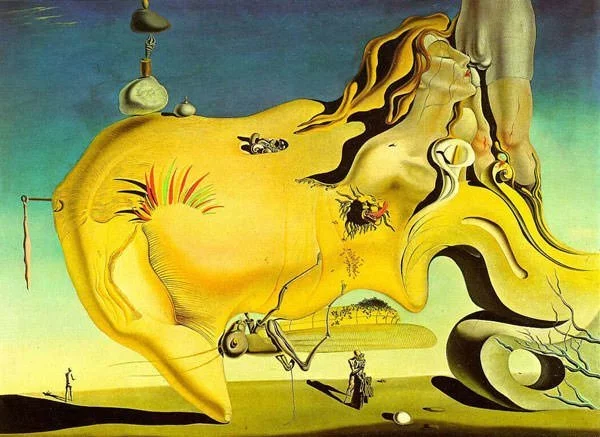
| Spanish Title: | El gran masturbador |
| Location: | MNCARS, Madrid, Spain |
| Year: | 1929 |
In 1929, Salvador Dali met Gala, who became his muse and later his wife. This canvas was created in the same year and is thought to reflect the erotic transformation that the artist underwent due to her arrival in his life. The main yellow area in the painting represents the artist himself sleeping. Out of his head comes the vision, probably representing an erotic fantasy, of a nude female figure, resembling his muse, drawn to the genitalia of a man, presumably the artist. Seen by many as a bizarre self-portrait, the disturbing composition is further plagued by additions like the fish-hook, the bleeding cuts, ants crawling on his face and a grasshopper which has attached itself to his face. The Great Masturbator is renowned for glorifying something that is usually ridiculed and is among Dali’s most controversial paintings.
#3 Soft Construction with Boiled Beans
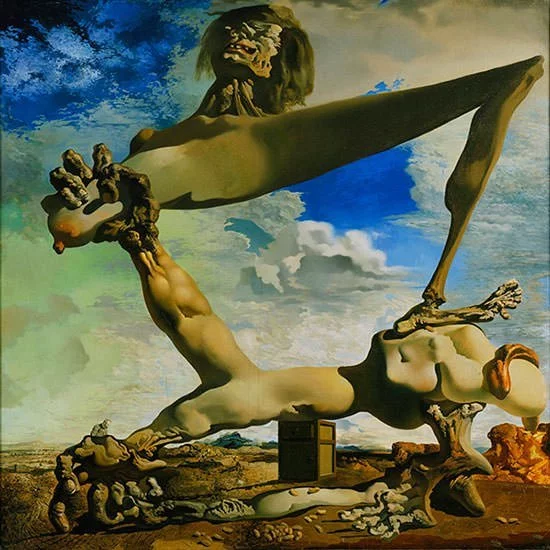
| Spanish Title: | Construcción blanda con judías hervidas |
| Full Title: | Soft Construction with Boiled Beans (Premonition of Civil War) |
| Location: | Philadelphia Museum of Art, U.S. |
| Year: | 1936 |
Salvador Dali painted this masterpiece six months before the Spanish Civil War began. He claimed to have been aware of the war due to “the prophetic power of his subconscious mind”. The painting reflects his anxiety during the time and predicts the horror and violence in the war. It portrays two bodies, one darker than the other, in a gruesome fight where neither appears to be a victor. The monstrous creature is self-destructive just as a civil war is. Dali made sure the painting looked very realistic despite the fantastical creature it depicts. The boiled beans in the painting, which are also mentioned in the title, are perhaps a reference to the simple stew that was eaten by the poor citizens living through a difficult time in Spain. Soft Construction with Boiled Beans is considered one of Dali’s greatest masterpieces and is renowned for brilliant use of surrealism to depict the horrors of war.
#2 Swans Reflecting Elephants
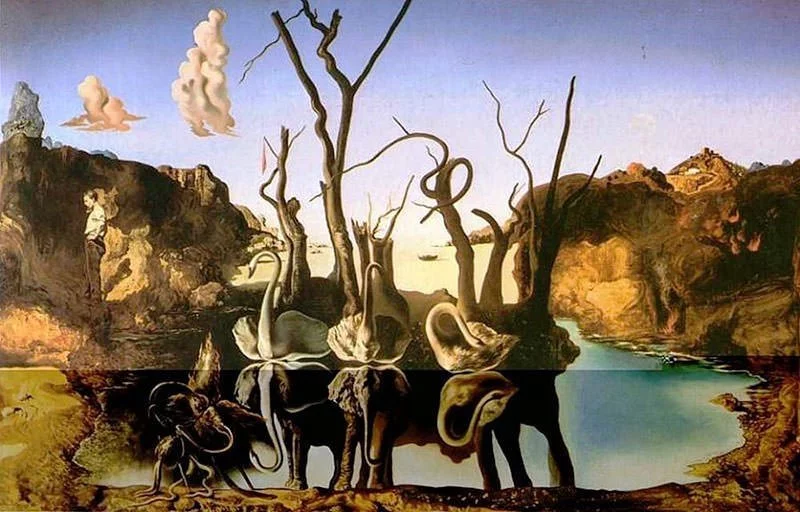
| Spanish Title: | Cisnes que se reflejan como elefantes |
| Location: | Private Collection |
| Year: | 1937 |
Double images were a major part of Dali’s paranoiac-critical method. Like in Metamorphosis of Narcissus, this painting uses the reflection in a lake to create a double image. The three swans in front of the trees are reflected in the lake so that their necks become the elephants’ trunks and the trees become the legs of the elephants. The landscape contrasts with the stillness of the lake as Dali has used swirl-like images to depict the background cliffs and skies. Swans Reflecting Elephants is considered a landmark painting in Surrealism as it enhanced the popularity of the double-image style. It is the most famous double image created by Salvador Dali; his greatest masterpiece using the paranoiac-critical method; and one of the most well-known works in Surrealism.
#1 The Persistence of Memory
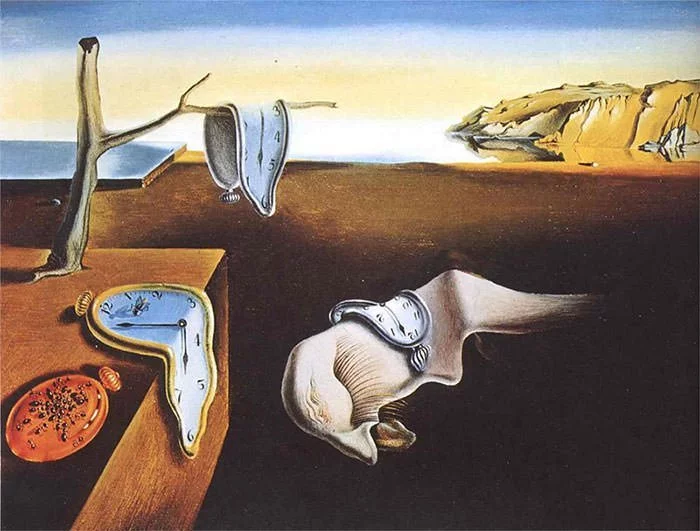
| Spanish Title: | La persistencia de la memoria |
| Location: | Museum of Modern Art, New York City, U.S. |
| Year: | 1931 |
This iconic and much-reproduced painting depicts a scene with watches melting slowly on rocks and the branch of a tree, with the ocean as a back drop. Dali uses the concept of hard and soft in this painting. This concept may be illustrated in a number of ways like the human mind moving from the softness of sleep to the hardness of reality. In his masterpiece, Dali uses melting watches and rocks to represent the soft and hard aspects of the world respectively. The Persistence of Memory has been much analyzed over the years as Dali never explained his work. The melting watches have been thought to be an unconscious symbol of the relativity of space and time; as a symbol of mortality with the ants surrounding the watches representing decay; and as irrationality of dreams. The Persistence of Memory is considered one of the greatest masterpieces of twentieth century art. It is not only the most famous painting of Salvador Dali but also the most renowned artwork in Surrealism.

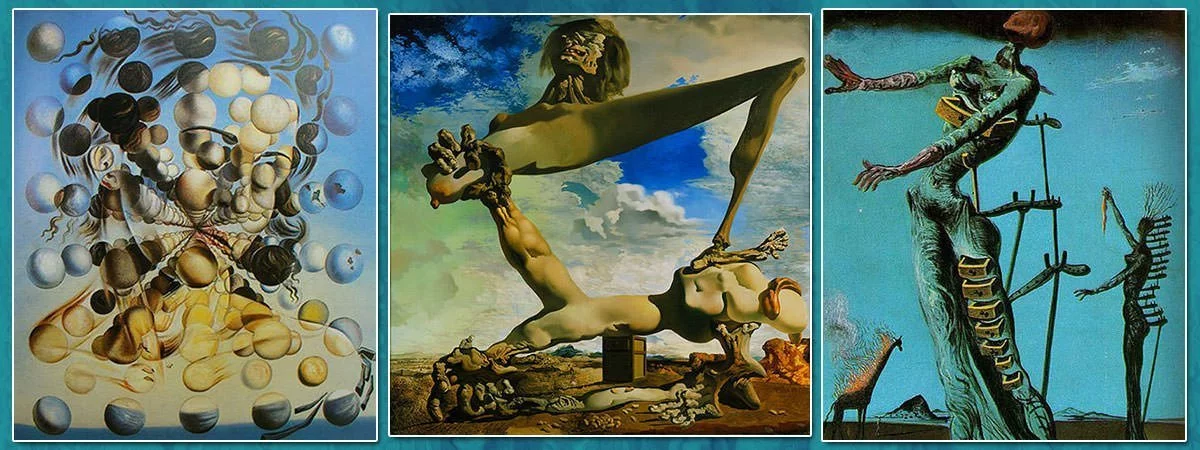
I would certainly put “Corpus Hypercubus” on that list, which is one of my favourites.
I admire a lot of the content on this site, but what are your sources? So far you guys seem to me like “Some guys that know some stuff” but I’m not entirely sure you’re qualified to make these lists without citations.
Currently we don’t provide citations. However, if you search for the content on the site on google, you will find the sources. The lists are made taking into account certain factors which give a clue about how famous an artwork is.
I regard something genuinely special in this internet site.